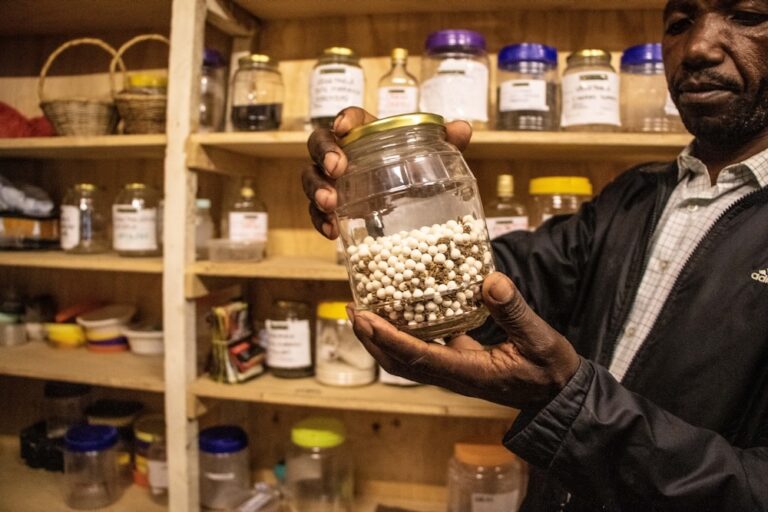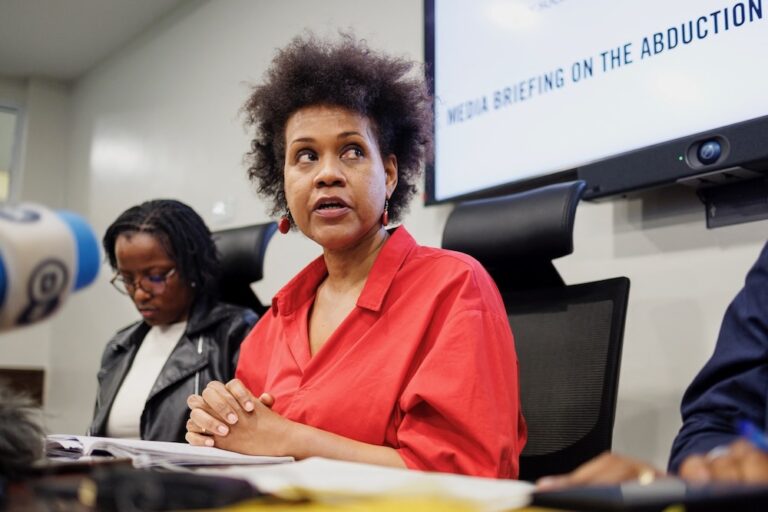(NDIMA/IFEX) – Following the 12 December 2000 NDIMA alert circulated by IFEX regarding the closure of the Internet exchange point by the Communications Commission of Kenya (CCK), the Telecommunications Service Providers of Kenya (TESPOK) provided NDIMA with a statement giving their side of the story. It is of interest to know that before NDIMA issued […]
(NDIMA/IFEX) – Following the 12 December 2000 NDIMA alert circulated by IFEX regarding the closure of the Internet exchange point by the Communications Commission of Kenya (CCK), the Telecommunications Service Providers of Kenya (TESPOK) provided NDIMA with a statement giving their side of the story.
It is of interest to know that before NDIMA issued the alert, the organisation made fruitless attempts to get TESPOK to comment. The following is TESPOK’s statement:
Statement by TESPOK on the Kenya Internet Exchange Point
Preamble
Certain sections of the press have quoted CCK officials and, more specifically, the Director General of the CCK in regard to the Telecommunications Service Providers of Kenya (TESPOK) and the recently closed Kenya Internet Exchange Point (KIXP). This statement hopes to make the facts surrounding KIXP known and chart a way forward for the development of the Internet in Kenya.
TESPOK was launched 12 months ago as a non-profit association to represent the interests of ISPs and other value added telecommunications services. Our aim was to further the growth of Kenya’s Internet society. During that time there have been many changes in the industry, not least of which has been the increase in licensed ISPs from 8 to 47.
Necessity for a Local Traffic Exchange
One of the key items on TESPOK’s agenda has been an effort to address the long standing problem of e-mail and web traffic from one ISP to another going out over international links and being exchanged overseas, sometimes traversing two or more continents to get to a correspondent across the street. The solution to this problem came in the form of a proposal to establish a Kenyan Internet Exchange Point (KIXP).
Currently all traffic, local and international has to be routed over Jambonet circuits. The cost of a Jambonet Internet circuit is vastly higher than that of a local Kenstreams digital link, ISPs are paying dearly for local traffic that is using their international links (between 200-400 Megabits a day).
Bandwidth
64K
256K
512K
Jambonet
US$ 3,375
US$ 6,750
US$ 9,546
Kenstreams
US$ 200
US$ 375
US$ 650
Efforts made by TESPOK
1) 3-12-1999: TESPOK wrote to the Manager, Data Services, Telkom Kenya informing him of the plans for KIXP and requesting Telkom Kenya to host KIXP. There was no response to this communication.
2) TESPOK’s Chairman then sought an audience with Telkom Kenya’s General anager for Operations & Maintenance during which the request was repeated. TESPOK’s request was denied.
3) TESPOK held consultations (among the ISPs) and decided to identify a suitable, neutral location to host the KIXP. Failing to locate an ideal location TESPOK rented offices in Bruce House, Nairobi for this purpose.
4) 19-7-2000: TESPOK wrote a letter to the Director General, CCK, to confirm verbal discussions concerning KIXP.
5) CCK wrote back to TESPOK on July 31st, 2000 requesting a meeting with TESPOK officials for “further consultations”.
6) TESPOK’s Chairman met with CCK’s General Manager, Telecoms Development and went into the details of the KIXP proposal. CCK gave every assurance that KIXP did not require a license and did not in any way infringe upon Telkom Kenya’s monopoly.
7) There was a second meeting between TESPOK’s Chairman, Cisco Systems, and CCK’s General Manager, Telecoms Development on November 24th in which the CCK General Manager affirmed the approval of KIXP. Cisco Systems would not have initiated work nor proceeded work on the KIXP unless there was local regulatory approval. The meeting on the 24th was held to answer any further questions or concerns CCK held on the IXP. None were given.
8) TESPOK proceeded to implement KIXP which went live with four ISPs exchanging traffic. TESPOK Announces the KIXP launch.
9) TESPOK’s chairman received a call from Telkom Kenya’s GM Operations and Maintenance during which he threatens to to shut down KIXP.
10) 24-11-2000: TESPOK’s Chairman wrote to the CCK to confirm the previous discussions, and notify the Director General that KIXP was now operational.
11) 30-11-2000 & 4-12-2000: CCK officials visit the KIXP. On the second visit speaking with the Chairman of TESPOK, who explains the functionality of KIXP. The officials seem satisfied with the fact that KIXP is not violating any laws or monopolies.
12) 7-12-2000: CCK writes to TESPOK demanding the immediate closure of KIXP and by copy of the same letter instructing Telkom Kenya to disconnect all ISP lines to the KIXP and to “provide all the internet backbone services including local e-mail and other similar services for which KIXP was intended to provide”.
Interpretation of the Kenya Communication Act, 1998
An Internet Exchange Point (IXP) is a “meeting place” for ISPs where they can exchange local traffic without having to pass this traffic over costly, slower international links. Each ISP pays for their circuit and router into the IXP datacenter. Local Area Network (LAN) technology is used to interconnect each ISP’s router. Since an IXP is in one way a Local Area Network (LAN) and another way a ‘closed user group,’ readings of the Kenya
Communications Act indicated that the KIXP did not need a license. To affirm this reading, TESPOK held several meetings with CCK during which there was a confirmation that the KIXP did not need a license. If indeed ethernet LANs need a licence then by extension every corporate, government office, and educational institute are breaking the law by operating LAN’s without a licence.
Proposed way forward
In acting in this manner, CCK has clearly placed Telkom Kenya’s interests before those of the consumer (the public), the service providers (ISPs) and the Government, (as there are many Government agencies that are serviced by local ISPs). All of these stakeholders are missing out on the benefits associated with local traffic exchange. There is a need for greater dialogue on KIXP and other concerns that TESPOK have brought before the CCK such as limitations of Telkom’s access network, unreliable Jambonet, delays in leased line connections among others.
The recent occurrences have raised much alarm both in local as well as international circles as they are indicative of “heavy-handed” regulation where expert opinion is not sought, vested private interests are preferred over public interests and power is misused.
Telecommunications Service Providers of Kenya
What did it entail to set up the Kenya Internet Exchange Point?
Internet Exchange Points (IXPs) are in existence all over the world. They have been termed as the “building blocks” of the Internet. The main purpose for IXPs is the localization of internet traffic between service providers in a city, region or country. A good reference for seeing the global dispersion of IXPs is http://www.ep.net
As evidenced across the globe, the hardest part of setting up an exchange point is getting service providers to work together cooperatively. This “social engineering” is 90% of the work that goes into setting up a successful IXP. The remaining 10% is technical, financial and logistical. Kenya has been no exception to this rule and it took over two years of
meetings, discussions, consultations and planning to get the collective will to establish KIXP.
Once the 90% “social engineering” was out of the way, the remaining 10% fell together quite quickly. A budget for the total setup was made, discussed between TESPOK member ISPs, agreed on and the setup expenses were split between the various ISPs. Each ISP is also responsible to pay for their own circuit and router to the KIXP. The average initial expenditure per ISP being something in the region of 250,000/= to 300,000/=. Each member ISP then makes a donation towards the expenses of running the IXP on a monthly basis.
Does KIXP mean that Telkom loses any revenue?
On the contrary, Telkom stands to gain the most from KIXP. The concept is very simple. Currently each ISP is paying Telkom for a Jambonet link to route their internet traffic. This Jambonet link is costing x amount of dollars a month. To get connected to KIXP, the ISP will take an additional link from Jambonet at y amount of dollars a month. The fees paid to Telkom for both lines are flat fees and are not based on the amount of data transmitted or the usage of the link. This means that now Telkom is being paid x + y dollars a month for the ISPs internet connectivity.
No ISP in their right mind is going to reduce their internation bandwidth because this is the arena in which ISPs compete. Who has the fastest links? Who has the fastest service? These questions can only be answered by each ISP taking more and more and more bandwidth from Telkom Kenya. Which, of course means more and more and more money for TKL.
Trends in Other Parts of the World
As mentioned earlier, IXPs are in place all over the world. I have attached a more exhaustive list of exchange points around the world. Africa has been behind in this area of Internet development as South Africa has been the only country in Africa with exchange points as follows:
CINX – Capetown IIX http://www.jinx.net.za/cinx/
JINX – Johannesburg IIX http://www.jinx.net.za/jinx/index.html
South African Internet Exchange (Telecom) -http://www.saix.net/
Uniforum’s version of the SA Internet Exchange – http://www.uniforum.org.za/
What benefits does an exchange point bring?
An exchange point creates an environment in which local online communities can evolve. Entertainment applications such as online gaming are very bandwidth sensitive and intolerable of long-distance lines. Online gaming thrives in networks that are interlinked at an exchange point.
E-commerce is driven by healthy exchange points. Without exchange points linking ISPs, the delays and latency on conventional international links severely disable “real-time” commercial applications. Most e-commerce are designed to be bandwidth sensitive and the reliability of the link between an e-commerce server and an e-commerce client is very crucial. The “jitter” normally associated with conventional international links means that most of these applications cannot work in an environment where there is no well designed internet exchange point.
Other real-time applications like video-conferencing and internet radio are big winners in an environment where there is an internet exchange. Could you imagine all the current radio stations starting to stream their programs over the internet to a much wider local audience than they could reach over the airwaves? Well, it’s a reality in every other country where there is an exchange point.
Our Government recently created a new division in the Ministry of Finance which has been charged with starting an program of implementing e-governance across all government agencies. One day a Kenyan will be able to apply for their passport online, renew their driving license online. Access and purchase all the documents at Government press online. Submit their tax information online and a host of other routine functions that currently take hours, days and even weeks to complete. This kind of e-government will not and can not be a reality without a thriving internet exchange environment with multiple exchange points across the nation, giving locals quality, high speed access to government content.
In a nutshell you cannot build the internet without Internet Exchange Points. They are the building blocks of the Internet. The Kenya Internet Exchange Point was the first brick that Kenya was going to contribute to what we know as the Internet today but it was removed even before the cement could dry, what a pity….


